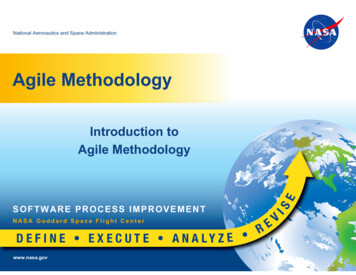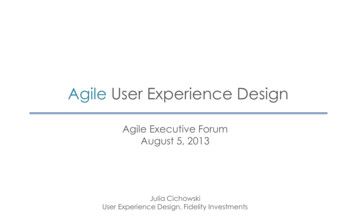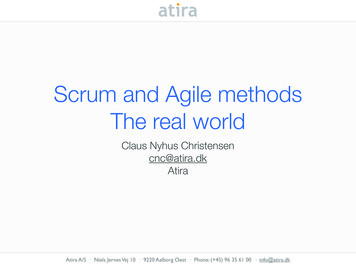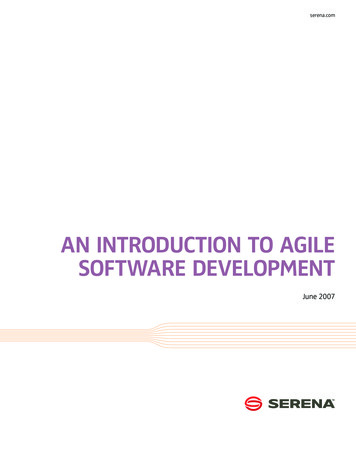
Transcription
National Aeronautics and Space AdministrationAgile MethodologyIntroduction toAgile MethodologySOFTWARE PROCESS IMPROVEMENTNASA Goddard Space Flight Centerwww.nasa.govSOFTWAREPROCESS IMPROVEMENTNASA GSFC
Agile Methodology Introductions– Alex Durkin, Software Process Improvement Teamhttp://software.gsfc.nasa.govSOFTWARE PROCESS IMPROVEMENTNASA GSFC2
Goals Common understanding of Agile fundamentals––––Origins of AgileKey Concepts / Activities / RolesCommon MisconceptionsStrengths and WeaknessesSOFTWARE PROCESS IMPROVEMENTNASA GSFC3
What is Agile? Definition*: The Agile Alliance defines Agile Software Development in thisway:In the late 1990’s several methodologies began to get increasing publicattention. Each had a different combination of old ideas, new ideas, andtransmuted old ideas. But they all emphasized:– Close collaboration between the programmer team and business experts– Face-to-face communication (as more efficient than written documentation)– Frequent delivery of new deployable business value– Tight; self-organizing teams working cooperatively– Ways to craft the code and the team such that the inevitable requirements churnwas not a crisis The Agile Manifesto was written in February of 2001, at a summit of 17independent-minded practitioners of several programming methodologies. *Definition of Agile from Agile Alliance, a non-profit organization founded by some authors of the original Agile Manifesto to advance Agile SOFTWARE PROCESS IMPROVEMENTNASA GSFC4
What is Agile? Interestingly, Agile concepts are applied to fields outside of software– Toyota implemented Agile techniques long before software development One of which was a task board in 1953, in Agile software development this became knownas a Kanban board– Team Wikispeed is using an Agile method called Scrum to build a fast, affordable,ultra-efficient, safe commuter car that should sell for less than 20,000 There are many methods implementing the Agile Software DevelopmentMethodology. Most notable:– Lean– Kanban– Extreme Programming (XP)– Scrum -- most popularSOFTWARE PROCESS IMPROVEMENTNASA GSFC5
Agile Methods In Use6050403020100% Adopted Version One 9th Annual State of Agile SurveySOFTWARE PROCESS IMPROVEMENTNASA GSFC6
Scrum FrameworkOriginal diagram from the Scrum AllianceSOFTWARE PROCESS IMPROVEMENTNASA GSFC7
Scrum – Key Concepts Product BacklogThe product backlog is a list of requirements (as user stories) and technical taskswhich the team maintains and that, at a given moment, are known to be necessaryand sufficient to complete a product or a release– The product backlog is the primary point of entry for knowledge about requirements, andthe single authoritative source defining the work to be done– Includes features, defects, and other technical work– Any format: Excel document, a text file, a databaseAgile teams commonly use a collection of index cards or Post-It notes on a task board (Kanban) Sprint BacklogThe sprint backlog is a working subset of the product backlog, small enough to becompleted in a single sprint All Term definitions from the Agile Alliance, the Scrum Alliance, the Mountain Goat Software website by Mike Cohn, a founder of the Agile Alliance; and theAgile Modeling website by Scott Ambler, author of “Disciplined Agile Delivery”.SOFTWARE PROCESS IMPROVEMENTNASA GSFC8
Scrum – Key Concepts User StoryA user story is a method to capture desired product features from the perspective of a user orcustomer.– Defined and sorted by priority into the Product Backlog by Product Owner– Concise enough to fit on an index card– Each user story is expected to yield, once implemented, a contribution to the value of the overallproduct, irrespective of the order of implementation– Generally high level at first, they can evolve and be refined into low-level user stories, or requirements It’s often best to think of the written part as a pointer to a real requirement Detail can be added by adding “conditions of satisfaction”– Stories can be assigned points based on size and complexity– Commonly takes the form of:As a type of user , I want some goal so that some reason . Example:“As a power user, I want to specify files or folders for backup based on file size, date created anddate modified, so I can prioritize items for backup.” May belong to the higher-level user story (epic): “As a user, I can backup my entire hard drive.”SOFTWARE PROCESS IMPROVEMENTNASA GSFC9
Scrum – Key Concepts SprintThe sprint is a set amount of time (either 2 or 4 weeks) determined to be sufficient todevelop a working deliverable software based on the product backlog– It is a time-boxed effort, completing all 4 phases (analysis, design, implementation, testing) Automated testing is widely used in Agile– The end product of the sprint is working software that is complete and potentiallydeliverable Daily Scrum, or Daily Stand-up – during the Sprint, less then 15 minutes– Purpose: Inspect progress, identify impediments to progress– Participants: Scrum Master and Team – Product Owner and other stakeholders are invited in listenonly modeThe daily stand-up is 10-15 minute daily briefing while standing– Each team member addresses:–What did I do yesterday that helped the Development Team meet the Sprint Goal?–What will I do today?–Are there any roadblocks in my way?SOFTWARE PROCESS IMPROVEMENTNASA GSFC10
Scrum – Key Concepts Sprint Planning – at most 8 total hours for a one month Sprint– Purpose: Determine work for next Sprint– Participants: Owner, Scrum Master, TeamThe sprint planning meeting is when the product owner describes the highest priorityfeatures to the team, and the team moves user stories from the product backlog intothe sprint backlog– Artifacts resulting are a Sprint goal and the Sprint backlog Sprint Review – after the Sprint, at most 4 hours– Purpose: Inspect completed work, adapt priorities for next Sprint– Participants: Owner, Scrum Master, Team, Stakeholders, other developersThe sprint review is a review meeting held at the conclusion of a sprint where theteam presents this software, as a demo or a test drive, to the external stakeholdersand discuss how to adapt the product to the overall feedback.– Artifacts resulting may be new user stories for the product backlog– Typically held to no more than 2 hours, and attended by Product Owner, Scrum Team,Scrum Master, and external stakeholdersSOFTWARE PROCESS IMPROVEMENTNASA GSFC11
Scrum – Key Concepts Burn-down chartA product burn-down chartshows the number of backlogitems completed vs yet to becompleted overall(updated after each sprint)A sprint burn-down chart showsthe number of remaining sprintbacklog items completed vs yetto be completed in the currentsprint(updated y/blog/burnupvsburndownchart Burn-up chartMore visible when the scope of the product changes, but harder toconvey when the end of the process will beSOFTWARE PROCESS IMPROVEMENTNASA GSFC12
Scrum – Key Concepts Retrospective – after the Sprint Review, before the next Sprint Planning, atmost 3 hours– Purpose: Identify improvements to Team development process– Participants: Scrum Master and TeamThe retrospective is a dedicated period at the end of each sprint todeliberately reflect on how the team is doing and to find ways to improve.– Typical artifacts are lessons learned to be reviewed next retrospective– Scrum master asks: “What went well during the sprint? “What could be improved in the next sprint?” VelocityThe velocity is a measure of how much work was completed during the sprint– Usually measured in stories completed or story points instead of hours– Allows for scoping of future sprintsSOFTWARE PROCESS IMPROVEMENTNASA GSFC13
Scrum – Key Concepts Technical debtThe technical debt is unfinished work after a sprint is over– Can build up over several sprints– Gets prioritized and placed on the Product Backlog Sprint ZeroSprint Zero, or the sprint before sprints, is a phrase coined for an initialsprint limited to project setup and initiation– Used for planning the sprint backlog, performing installs, and other prepactivities– No released software– Still a 2-4 week period, like any other sprintSOFTWARE PROCESS IMPROVEMENTNASA GSFC14
Scrum – Additional Concepts Product Backlog Refinement – less then 10% of total team effortBacklog refinement, or grooming, is the process of soliciting, refining and rankingrequirements by the Product Owner with input from the Team and Customers– Users stories can be added, removed or split– Priorities and estimates are developed or changed– All stakeholders should understand the ranking criteria and resulting priorities Hardening SprintA hardening sprint is an additional sprint that some Scrum Teams perform to readythe product for release– Controversial concept that isn’t universally accepted– Scrum teams often use it to tie up the loose ends identified during this sprint or earliersprints All Term definitions from the Agile Alliance, the Scrum Alliance, the Mountain Goat Software website by Mike Cohn, a founder of the Agile Alliance; and theAgile Modeling website by Scott Ambler, author of “Disciplined Agile Delivery”.SOFTWARE PROCESS IMPROVEMENTNASA GSFC15
Scrum RolesExternal Stakeholders: User – The end user of the product Customer – Client often paying for the work Management – Use a hands-off approach with the technicalteam, coordinate with product owner, attend milestonereviews as “listen-only”Internal Stakeholders: Product Owner – Represent the interests of the externalstakeholders, act as a filter between team and externalstakeholders, maintain the product backlog Scrum Master – Leading member of the team that focuses onthe success of the sprint, runs the daily stand-up Scrum Team – A cross-functional team made up of thedevelopers, testers, architects, administrators and softwareassurance Co-located, frequent communication - at the least meets dailyRecommended size of 3-9 peopleSelf-organizing but within a set boundaryThe focus is to get work done, even if you need help rumdeel-1/ Scrum Role definitions derived from the Scrum Methodology and the Scrum AllianceSOFTWARE PROCESS IMPROVEMENTNASA GSFC16
SOFTWARE PROCESS IMPROVEMENTNASA GSFC17
Common Misconceptions Agile is synonymous with ScrumAgile means no documentationAgile means no planning – just codingAgile only works when everyone is co-locatedAgile means faster and cheaper The Agile Manifesto: e-manifesto/SOFTWARE PROCESS IMPROVEMENTNASA GSFC18
Common Misconceptions “Agile is synonymous with Scrum”– Scrum is one development method that implements Agile (the most popular one)– Scrum is constantly evolving through an active community, leading to manyhybrid adaptations– Scrum implements all the values and principles of Agile Scrum and Agile, synonyms? (and other Agile methodologies)SOFTWARE PROCESS IMPROVEMENTNASA GSFC19
Common Misconceptions “Agile means no documentation”– A focus in Agile is working software over documentation (but not instead ofdocumentation)– Agile calls for more frequent updates to documentation– Documentation is done real time focusing on the sprint, rather thandocumenting everything all at once– The Agile version of documentation says: There is an overall planThere are requirements descriptionsThere are cost and schedule estimatesThere are risk assessmentsThere is training material (as appropriate)There is documentation (as appropriate)There are lessons learned (based on retrospectives) What Does the Agile Manifesto Mean? andAgile software development, the principles. Principle 9 : Continuous attention to technical excellence and good design enhances agilitySOFTWARE PROCESS IMPROVEMENTNASA GSFC20
Common Misconceptions “Agile means no planning – just coding”– Agile seeks to eliminate “analysis paralysis” through shorter planning cycles,hopefully 2-4 weeks– Teams are self-organizing, so Agile is not focused on task assignments– In Scrum, sprint planning can evolve each sprint Sprint planning before each sprint Sprint Zero is 2-4 weeks of planning before coding starts Developers can’t start coding in a sprint until the Scrum master has picked out the UserStories for the Sprint Backlog After the end of every sprint, a few hours are spent planning– While the development lifecycle is dynamic, product plans and system testing arestill necessary What Does the Agile Manifesto Mean? andAgile software development, the principles. Principle 11: The best architectures, requirements, and designs emerge from self-organizing teamsSOFTWARE PROCESS IMPROVEMENTNASA GSFC21
Common Misconceptions “Agile only works when everyone is co-located”– Agile is heavily focused on face-to-face communication This does not mean teams have to be co-located - video conferencing is onesolution Be aware that a more geographically distributed team could then increase cost The Agile methodology stresses that email and phone conversations are nosubstitute for the daily meetings– A mitigation for a user not co-located is to employ a local user representative– There are Agile scaling techniques to accommodate multiple teams in separatelocations Two different scrums in two different locations operate as normal, and the ScrumMasters from each meet to define Sprint Backlog What Does the Agile Manifesto Mean? andAgile software development, the principles. Principle 6: The most efficient and effective method of conveying information to and within a developmentteam is face-to-face conversation.SOFTWARE PROCESS IMPROVEMENTNASA GSFC22
Common Misconceptions “Agile means faster and cheaper”– Agile defines short development and delivery cycles This means that a working product is delivered faster From the customer’s point of view, they receive success faster Leads to a ‘fail fast’ scenario, where they realize that a product solution may be flawed,correcting their course early and potentially saving money– However Agile has a steep learning curve Inexperience with Agile can lead to delays, building up technical debt or difficulty planningsprints Sometimes leads to performing traditional methods when you thought you were beingAgile– It’s common not to see added benefit to Agile until late in the lifecycle– Other Agile implementation can have different cost impacts Pair programming and other XP techniques often cost more Agile Alliance, the Scrum Alliance, the Mountain Goat Software website by Mike Cohn, a founder of the Agile Alliance; and the Agile Modeling website byScott Ambler, author of “Disciplined Agile Delivery”.SOFTWARE PROCESS IMPROVEMENTNASA GSFC23
Agile: Strengths and WeaknessesStrengths Users are kept involved in the process daily,increasing likelihood of validationWeaknesses Dependent on availability of users/customersor their representatives Accepts changes in requirements during allstages of development Increases in difficulty for larger developmentteams High amount of risk analysis done Requires strict adherence to activities Avoid “analysis paralysis” by diving intodevelopment early Some methods are more expensive (Pairprogramming) Working products are available throughout theprocess Customer involvement can increase reworkor gold-plating Thrives with co-located teams Added complexity for dispersed teams Documentation is done real-time, during eachiteration Documentation not done real-time can lackimportant details Strengths and weaknesses assisted by the Scrum Alliance and Version One – Agile made easy / as well asBefore you make the leap to Agile – Ten weaknesses of AgileSOFTWARE PROCESS IMPROVEMENTNASA GSFC24
Is Agile right for me?A successful Agile methodology depends on embracing several keyconcepts (by both the development team and by management): Having continuous user involvement Having frequently deliverable software Accept changes in requirements, even late in development Daily communication and focus on efficiency through daily face-to-facestand-ups Using retrospectives to reflect and improve every iteration Trust that all team members and stakeholders will support the approachEven if you’re not fully doing Agile, many of these concepts can still be used toconstruct strong project practices, like user involvement and demonstrations.And most importantly, tailor to the task. Agile only asks you to inspect and adapt,how you do that is up to you. See Water-Scrum-Fall article from the Scrum AllianceSOFTWARE PROCESS IMPROVEMENTNASA GSFC25
QuestionsDiscussionCloseout Contact Alex Durkin with questions Final slides on Software website, Training section, http://software.gsfc.nasa.govSOFTWARE PROCESS IMPROVEMENTNASA GSFC26
References Agile Alliance – http://www.agilealliance.orgScrum Alliance – https://www.scrumalliance.org/Mountain Goat software - https://www.mountaingoatsoftware.com/Ken Schwaber’s Blog - https://kenschwaber.wordpress.com/Some Agile Methods - /3Top 10 Agile myths - http://www.agileconnection.com/Version one - opment-survey-ninth.pdfKanban - https://www.atlassian.com/agile/kanbanAbout Agile - http://www.agilealliance.org/the-alliance/About Scrum - http://scrummethodology.comScrum Roles - -values-rolesState of Scrum - https://www.scrumalliance.org/Weaknesses: les/before-making-the-leap-to-agilePrinciples and definitions - nl/2008/07/01/Bob Winter (2015). Agile Performance Improvement Synergy Technology, retrieved ement-Synergy-Technology/dp/1484208935SOFTWARE PROCESS IMPROVEMENTNASA GSFC27
SOFTWARE PROCESS IMPROVEMENT NASA GSFC Interestingly, Agile concepts are applied to fields outside of software – Toyota implemented Agile techniques long before software development One of which was a task board in 1953, in Agile software development this became known as a Kanban bo










